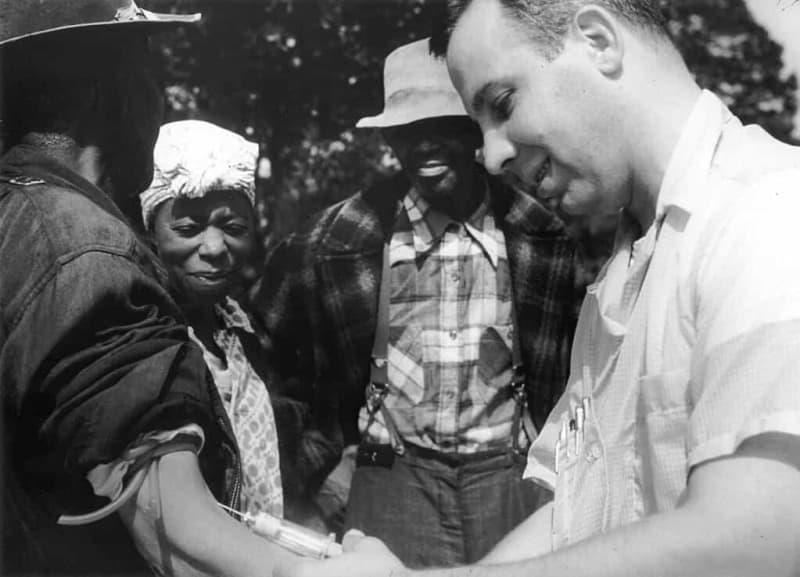Remembering the Tuskegee experiment: when rural Alabama Black men were intentionally exposed to syphilis with no treatment

The Tuskegee Syphilis Study is a shameful reminder of what science without ethics can lead to. Starting in the early 1930s, this experiment conducted by the Public Health Service (PHS), the precursor federal public health agency to today’s CDC, deliberately withheld life-saving therapy against syphilis from more than 400 vulnerable Black men from rural Alabama.
The Black men enlisted in the study were lied to and manipulated, and local authorities turned a blind eye for the 40 years that the experiment was allowed to run its course, with the participants essentially relegated to human guinea pigs. Cynically, the Tuskegee participants were deceived into thinking they were actually receiving expert medical care when the opposite was true. It wasn’t until 1972 that the inhumane experiment ended after a social worker whistleblower revealed the ghastly situation to the media.
As if this wasn’t enough, in 2010, we learned that the same research group intentionally infected hundreds of Guatemalan men with syphilis and gonorrhea in the 1940s to test new prophylactic medicine designed to prevent such infections. Yet again, these men had no idea what they were getting themselves into and were repeatedly deceived as to the real goal of the research. No genuine informed consent was given.
In an editorial published in the American Journal of Respiratory and Critical Care Medicine, Dr. Martin Tobin from the Hines Veterans Affairs Hospital and Loyola University of Chicago Stritch School of Medicine revisits this dark period of science and American history and lists some of the most important lessons to prevent something like this from ever happening again.
“Readers can acquire a better understanding of research ethics by reading about the Tuskegee Study than by reading about abstract principles of research integrity in a bioethics textbook,” Dr. Tobin said in a statement. “The story provides a vivid narrative with real live characters – victims, villains, and a hero– and readers can relate these characters to people they encounter in their daily lives.”
The Tuskegee Experiment
The Tuskegee experiment (1932-1972) has gone down in history as a dark stain on medical research due to the horrendous way the patients were treated, a fact made all the more ignominious seeing how the study was conducted by the US government’s foremost health agency.
The experiment was meant to study the effects of untreated syphilis, a devastating and life-threatening sexually transmitted disease caused by the bacterium Treponema Pallidum. The original researchers who kicked off this unsavory study chose Macon County, Alabama, a town of 27,000 people in 1932, more than 80% of whom were Black. To help with recruiting, the PHS researchers signed a partnership with the nearby Tuskegee Institute, a black university founded by former slave Booker T. Washington.
The study recruited 600 Black men, 399 of whom had syphilis and 201 who were free of disease to serve as controls. Most of these ‘volunteers’ were poor sharecroppers with little if any formal education, who still worked under white farmers. To entice them to participate, the Macon men were offered free medical care and, most importantly, burial insurance. A proper burial is very culturally important to this community, but also prohibitively expensive.
By 1969, up to 100 of these men died as a result of their disease, which went on untreated, but the physicians carried on with their experiment regardless. That’s even though there were working, proven treatments developed against syphilis during the 40 years that the study, known as the Tuskegee Study of Untreated Syphilis in the Negro Male, was active.
Instead of being given mercury compounds, a crude form of treatment for syphilis that nevertheless works and which has been used since the 16th century, or penicillin, invented in 1928 and to this day the best way to get rid of the disease, the Black men were given vitamin tonics and aspirin, effectively placebos.
It gets worse. Once the researchers made their initial assessments, they next wanted to verify evidence of neurosyphilis (syphilis infection to the central nervous system), which requires a spinal cord biopsy. Dr. Raymond Vonderlehr deceived the Alabama men by telling them they would get free “spinal shots”, tricking them into thinking they were being treated when in reality the lumbar punctures were for a totally different purpose.
The final and perhaps most important phase of the study was when the subjects very predictably died and had to be autopsied “so that pathological confirmation may be made of the disease processes,” Hugh Cumming, the Surgeon General at the time, wrote to a letter to the Direct of Andrew Hospital.
Yet again, the participants and their families were deceived. PHS investigator, Dr. Oliver Wenger, wrote to Dr. Vonderlehr “if the colored population become aware that accepting free hospital care means a post-mortem every darkey will leave Macon County.” So the PHS researchers promised to cover the participants’ burial expenses if they enrolled in the hospital during their final days.
Many of the Tuskegee Experiment’s participants were saved thanks to pure luck, as they were treated with penicillin when they became sick with other infections by doctors not affiliated with the study.
“As such, the Study was not one of untreated syphilis, but rather of under-treated syphilis,” Dr. Tobin wrote in his commemorative editorial.
What was particularly insane about the Tuskegee experiment is that it wasn’t kept a secret. The PHS researchers published results from the study in prestigious medical journals starting in 1936. One article published in 1955 reported that more than 30% of the men in the study had died due to advanced syphilis. Among the physicians and scientists in the country who had access to these scientific articles, the Tuskegee Experiment was very open, yet no one protested.
It seems like all of the people involved in this unconscionable medical research, from the PHS investigators up to the Surgeon General himself, were of severely clouded moral judgment, undoubtedly owed to their racism — all but one.
In 1965, 29-year-old Peter Buxton joined the study as a psychiatric social worker. He was so appalled by what he witnessed that he sent a letter to the director of the Division of Venereal Diseases of the CDC expressing his concerns. The CDC invited Buxton to a meeting, where he was confronted by one of the PHS investigators who chastised him for his rebellious comments.
Buxton did not relent though and continued writing letters, one of which ended up in the hands of CDC director Dr. David Sencer, in 1968, who convened an investigation. The panel that reviewed the study and its findings dismissed Buxton’s concerns and decided against treating the Alabama men. This was when Buxton contacted a journalist who covered the despicable experiment in the Washington Star, on July 25, 1972.
The story made huge waves across the entire nation, and as a result of the scandal the Tuskegee Experiment was finally terminated in October 1972 and the surviving men were given immediate medical care. In the aftermath, the National Research Act was passed, which established the principles of informed consent and the protection of vulnerable populations.
However, the original investigators of the study were never held legally responsible. It was only in 1997 that the US government issued a formal apology through the voice of President Clinton who said: “What the United States government did was shameful … To our African American citizens, I am sorry that your federal government orchestrated a study so clearly racist.”
The Guatemalan Experiment
While she was investigating documents for her book, titled Examining Tuskegee, historian Susan Reverby came across the research records of Dr. John Cutler. To her surprise, she found no mentions of the study in Alabama. However, what was inside the records proved just as shocking, if not more.
The documents revealed that the PHS conducted a similar study between 1946 and 1948, wherein PHS doctors deliberately infected hundreds of Guatemalans with syphilis and gonorrhea without their knowledge or consent.
During this time, the U.S. was experiencing more than half a million new cases of syphilis each year. Something had to be done, and a lot of money was invested into research that might produce new and effective preventive medicine. Time was of the essence so ethical rules were thrown out the window.
Dr. John Mahoney, the architect of the Guatemalan STD experiments, initially worked with convicts from federal prisons. He and colleagues gave experimental medicine to 241 prisoners and then infected them with Neisseria gonorrhea by introducing the bacteria into their penises. Luckily for the prisoners, the physicians weren’t very good at producing infections and the experiment was called off in 1944.
In the meantime, Mahoney heard that prostitution was legal in Guatemala, where prisoners were even allowed the right to call on the services of prostitutes. So after acquiring funding from the federal government, Mahoney and his team set up camp in Guatemala where they tried to induce syphilis in Guatemalan prisoners and soldiers through sexual intercourse with infected prostitutes.
The problem was that only 10% of the intercourses resulted in infection, so the researchers began to artificially inoculate subjects with syphilis, gonorrhea, and chancroid. Dr. Tobin described the gruesome procedure:
“The investigators’ notebooks contain graphic accounts of steps in experiments. A physician held the penis of a participant, pulled back the foreskin, and “with some force, rolled the large inoculating swab over the mucosa so as to try to contaminate the entire fossa navicularis”. If enrolled prostitutes were uninfected, investigators inoculated women by moistening a cotton-tipped swab with gonorrheal pus, inserting it into the woman’s cervix and “swabb[ing] it around…with considerable vigor.”
To improve the infection rate, which they found too abysmally low, the American physicians tried out all manners of methods, including oral ingestion of syphilitic material and inoculating the rectum, urethra, and eyes of participants.
By 1948, at least 1,300 people were intentionally exposed to syphilis, gonorrhea, and chancroid, 60% to 87% of which showed evidence of disease and were not provided adequate treatment, resulting in 83 deaths. The experiment was halted in December 1948 with none of its findings ever published.
Reverby publicized her findings in the Journal of Policy History, and later the Obama administration appointed a commission to investigate the matter.
The lessons that shaped bioethics today
Reading about these experiments can be stomach-churning, but Dr. Tobin writes that there are three central lessons that we can gain from the Tuskegee Study: “the importance of pausing and examining one’s conscience, having the courage to speak, and above all the willpower to act.”
He added, “It is easy to articulate these steps but carrying out the steps requires a willingness to place oneself in jeopardy – a willingness to risk getting into trouble with supervisors and even losing one’s job.”
After the Tuskegee Study was made known to the public at large, research ethics went through fundamental reform. However, the wound never healed and to this day there is a lot of public distrust in science and structural racism, as seen recently by the stark racial disparities in health outcomes during the COVID-19 pandemic. Vaccine hesitancy can also trace, at least partly, its roots in opaque and unconscionable public health policies from history.
“A considerable portion of vaccine hesitancy, however, reflects a real decrease in trust in physicians and scientists – and especially in physicians with links to government,” said Dr. Tobin.
This article originally appeared in 2022. It was updated with new information before republishing.
Was this helpful?
Thanks for your feedback!
This story originally appeared on ZME Science. Want to get smarter every day? Subscribe to our newsletter and stay ahead with the latest science news.


